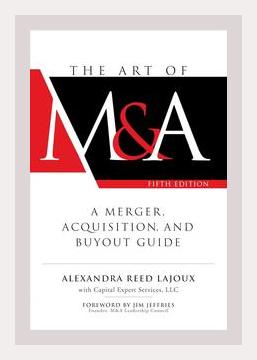Business StrategyMergers and Acquisitions
The Art of M&A, Fifth Edition: A Merger Acquisition Buyout Guide by Alexandra Reed Lajoux – A Summary
Introduction
The fifth edition of “The Art of M&A” by Alexandra Reed Lajoux is a comprehensive guide covering the multifaceted landscape of mergers and acquisitions (M&A). Recognized as an authoritative resource, the book elucidates every stage of the M&A process, integrating real-world examples, regulatory updates, and actionable advice, which the reader can adopt to navigate the complex terrain of corporate consolidations effectively.
Chapter 1: The Strategic Fit
– Major Points:
– Emphasis on due diligence to ensure strategic alignment.
– Importance of understanding the market dynamics and competitive landscape.
– Evaluation of cultural fit between merging entities.
- Examples:
-
The Facebook and WhatsApp merger: Strategic fit in terms of user base growth and technological integration.
-
Actionable Advice:
- Conduct thorough market research to understand where the target company stands in the competitive landscape and how it aligns with your strategic goals.
- Perform cultural assessments through interviews and surveys to ensure compatibility.
Chapter 2: Identifying Targets
– Major Points:
– Description of various methods to identify potential acquisition targets.
– Importance of aligning target search with strategic objectives.
- Examples:
-
Cisco’s acquisition methods including using a dedicated team to screen and identify potential tech startups that align with their technological strategy.
-
Actionable Advice:
- Set up a cross-functional team dedicated to identifying and evaluating potential acquisition targets that align with your company’s long-term objectives.
Chapter 3: Valuation Techniques
– Major Points:
– Discussion of different valuation techniques such as Comparable Company Analysis, Precedent Transactions, and Discounted Cash Flow Analysis.
- Examples:
-
Microsoft’s acquisition of LinkedIn, where a mixed valuation approach was used to justify the $26.2 billion purchase.
-
Actionable Advice:
- Use a combination of valuation techniques to get a robust estimate of the target company’s worth. Engage financial advisors to ensure accuracy and reliability.
Chapter 4: Funding the Deal
– Major Points:
– Types of financing options: equity, debt, and hybrid models.
– Decision-making factors affecting financing choices.
- Examples:
-
The leveraged buyout of Dell where Michael Dell and private equity partner Silver Lake used a mix of equity and debt financing.
-
Actionable Advice:
- Assess your company’s current financial health and explore a mix of financing options to optimize cost and financial leverage. Consult with financial experts to determine the best funding strategy.
Chapter 5: Legal Considerations
– Major Points:
– Key legal concerns including antitrust regulations, contract law, and intellectual property rights.
– Role of legal due diligence in preventing post-deal litigations.
- Examples:
-
Google’s acquisition of Motorola, complicated by antitrust scrutiny in multiple jurisdictions.
-
Actionable Advice:
- Engage with legal advisors early in the M&A process to navigate compliance issues and ensure all legal aspects are covered comprehensively.
Chapter 6: Due Diligence
– Major Points:
– Comprehensive framework for conducting due diligence across financial, operational, and legal fronts.
- Examples:
-
The Hewlett-Packard (HP) and Autonomy acquisition, which highlighted the dire consequences of insufficient due diligence, leading to a massive write-down.
-
Actionable Advice:
- Develop a structured due diligence checklist covering all critical aspects of the target company to uncover potential risks and validate assumptions.
Chapter 7: Negotiating Tactics
– Major Points:
– Techniques for effective negotiation including preparation, understanding the other party’s interests, and leveraging competition.
- Examples:
-
Disney’s acquisition of 21st Century Fox, wherein competitive bidding and strategic negotiations were pivotal.
-
Actionable Advice:
- Prepare extensively, understand your opponent’s priorities, and use leverage and alternative offers to negotiate more effectively.
Chapter 8: Integration Planning
– Major Points:
– Importance of pre- and post-acquisition planning for seamless integration.
– Alignment of operational, financial, and human resources to achieve synergies.
- Examples:
-
The successful integration of Pixar into Disney, resulting in significant operational and creative synergies.
-
Actionable Advice:
- Develop a detailed integration plan addressing key areas such as technology, operations, and culture. Assign a dedicated integration team to oversee the process.
Chapter 9: Post-Merger Management
– Major Points:
– Challenges and strategies for effective post-merger integration.
– Importance of continuous monitoring and feedback.
- Examples:
-
The Daimler-Benz and Chrysler merger, which failed due to cultural and operational disconnects, emphasizing the importance of post-merger integration.
-
Actionable Advice:
- Implement a robust post-merger management framework with regular progress reviews and adaptive strategies to address emerging issues.
Chapter 10: Special Situations: Distressed M&A and Cross-border Transactions
– Major Points:
– Unique challenges and opportunities in distressed M&A and international deals.
– Importance of understanding local regulations and economic conditions for cross-border transactions.
- Examples:
-
Lenovo’s acquisition of IBM’s PC business, highlighting the intricacies of cross-border M&A, including regulatory approvals and cultural integration.
-
Actionable Advice:
- For distressed M&A, focus on turnaround strategies and stabilize key operations. For cross-border deals, hire local experts to assist with regulatory, cultural, and market considerations.
Conclusion
“The Art of M&A” provides a detailed roadmap for navigating the complexities of mergers and acquisitions. It emphasizes the importance of strategic alignment, thorough due diligence, effective negotiation, and meticulous integration planning. By incorporating the actionable advice and real-world examples from the book, individuals and organizations can enhance their M&A capabilities and achieve successful outcomes.
By adopting the practical strategies and insights shared in this authoritative guide, executives and professionals involved in M&A can significantly improve their decision-making processes, mitigate risks, and maximize the potential for value creation in their transactions.
